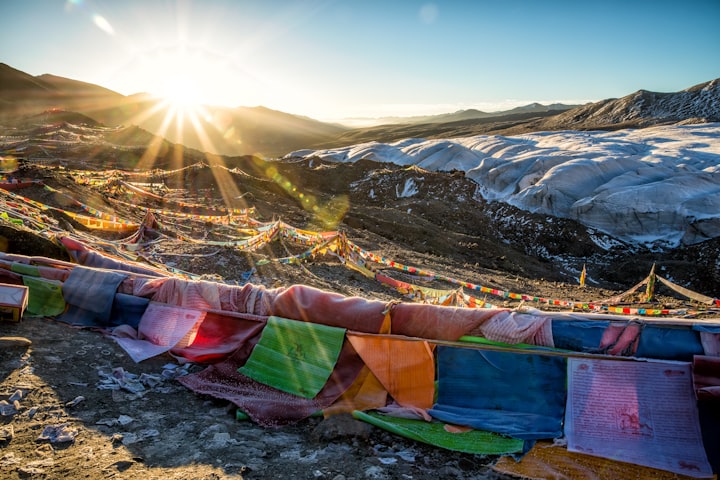
As the "roof of the world", the formation and evolution of the Qinghai-Tibet Plateau, especially the internal crustal deformation, thickening and uplift, and outward expansion, are the main focus of research in the field of earth sciences. For the special geological phenomena on the eastern edge of the Tibetan Plateau, such as large-scale slip faulting, significant crustal thickening, and lack of Cenozoic crustal shortening, three classical geological models have been proposed, namely, rigid block extrusion, continuous lithosphere-scale deformation, and large-scale middle and lower crustal flow. Among them, the large-scale (>1000 km) middle and lower crustal flow has received wide attention and support from many scholars in the last 20 years. This model suggests that the crustal thickening at the eastern margin of the Tibetan Plateau is caused by the eastward flow of crustal material from the interior of the Tibetan Plateau (the North Tangential Massif) at a depth of 25-40 km to join the eastern margin of the Tibetan Plateau. Geophysical observations show that there is an extensive low-velocity, a high-conductivity layer at the eastern margin and interior of the Tibetan Plateau that supports the flow of middle and lower crustal material that can occur. However, some scholars have questioned this, arguing that the model lacks geological evidence and that some recent findings do not seem to support the existence of such large-scale crustal flows.
According to the large-scale middle and lower crustal flow model, the significant Late Miocene-Pliocene uplift and lack of crustal shortening deformation on the eastern margin of the Tibetan Plateau are due to crustal flow. According to the prediction of this model, it takes about 20 million years to complete the crustal thickening and uplift, so the onset of crustal flow should be between 30 and 40 Ma. Second, for the crustal flow model, the pressure gradient is the initial and necessary condition for its formation, and the central part of the Tibetan Plateau was already at a high altitude in the Eocene, so it is possible that a pressure gradient existed between the central part of the Tibetan Plateau and the eastern margin during the Eocene. In addition, the observed high-temperature gradient between the central and eastern margins of the Tibetan Plateau is also a necessary condition for the formation of large-scale crustal flow. Thus, all the conditions required for large-scale crustal flow seem to be satisfied.

To investigate whether large-scale crustal flow shaped the eastern margin of the Tibetan Plateau, Fang-Yang H, a Distinguished Associate Researcher at the Key Laboratory of the Institute of Mineral Resources, Institute of Geology and Geophysics, Chinese Academy of Sciences, in collaboration with Yuan Wu, a member of the Chinese Academy of Sciences, Mikhail N. Adduce, a professor at the University of Arizona, and James B. Chapman, an associate professor at the University of Wyoming, USA, investigated the largest Cenozoic intrusive body on the eastern margin of the Tibetan Plateau. We have systematically studied the largest Cenozoic intrusive body in the eastern margin of the Qinghai-Tibetan Plateau, the Gong gar Mountains-Zeta Mountains granitic intrusive miscellaneous rock body. This miscellaneous rock body is located above the channel of large-scale crustal flow proposed by previous authors, and the crustal composition of the North Tangential Massif can be distinguished from that of the eastern margin of the Tibetan Plateau (Song pan-Ganglia Massif) according to the results of previous studies. Therefore, if there was a large-scale eastward flow of material within the crust during the Cenozoic period, the magma source area reflected by these granitic rocks should have changed since they are mainly derived from partial melting of the crust.
After field investigation and indoor analysis, and combined with the results of previous studies, the research team found that the Gong gar Mountain-Toledo Mountain intrusive magic body records multiple phases of pragmatism in both Mesozoic (215-172 Ma) and Cenozoic (50-3 Ma) phases, especially three phases of pragmatism in Cenozoic period, 50-30 Ma, 20-10 Ma, and 5-3 Ma, respectively. based on the isotopic compositions of rocks of different phases (Based on the isotopic compositions of the rocks of different periods, they found that the source area of these granitic rocks did not change from the Mesozoic to Cenozoic periods, and the magma mainly came from the basal lower crust and metamorphic sedimentary rocks of the Song pan-Ganglia massif). To determine whether the source areas of these rocks can represent the historiography of middle and lower crustal flows, the research team used People_X phase equilibrium simulations and trace element simulations to perform partial melt simulations by assuming different source areas, and the melt compositions obtained from the simulations basically match with the observed sample compositions, and thus obtained the temperature and pressure conditions for the formation of Cenozoic magmatic rocks. Based on the obtained temperature and pressure conditions, the team found that these Cenozoic gammas formed mainly at 30-40 km, which is generally consistent with the depth proposed by the crustal flow model. The results show that at this crustal depth where crustal flows should exist, there is no crustal material from the interior of the Tibetan Plateau, which is inconsistent with the predictions of large-scale crustal flow models.
The team further found that there are phase changes in the source area of Cenozoic magma, i.e. 50-30 Ma and 5-3 Ma granitic rocks from partial melting of metamorphic basalt rocks, and 20-10 Ma granitic rocks from partial melting of metamorphic sedimentary rocks, indicating two shifts in the source area of magma. These two transitions can correspond to the two uplift events on the eastern edge of the Tibetan Plateau and can correspond to the regional mantle source pragmatism. In addition, the long-term crustal pragmatism may have changed the theological properties of the crust and shaped the present-day geological features and morphological characteristics of the eastern margin of the Tibetan Plateau under the continuous India-Eurasia collision.
The related research results were published in Geophysical Research Letters. The research work was supported by the Center for Basic Science Program of the National Natural Science Foundation of China, the Young Scientists Fund of the National Natural Science Foundation of China, and the Surface Program of the China Postdoctoral Science Foundation.
About the Creator
Monu Ella
And I know it's long gone and there was nothing else I could do






Comments (1)
👍